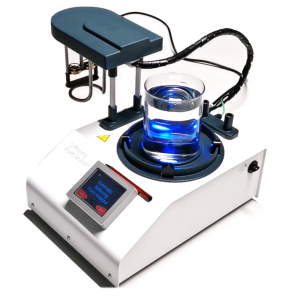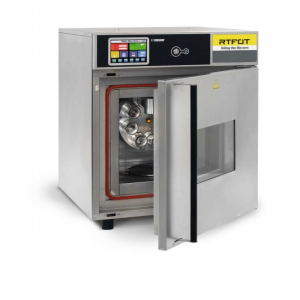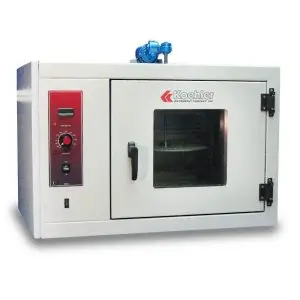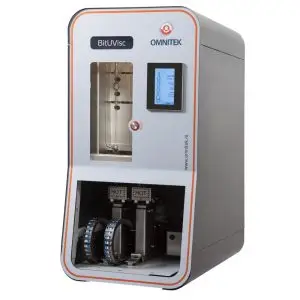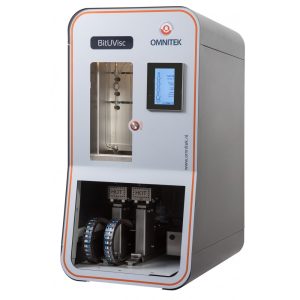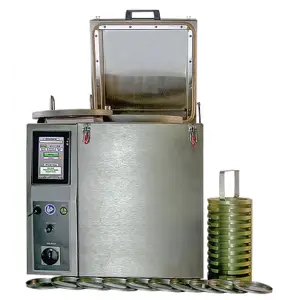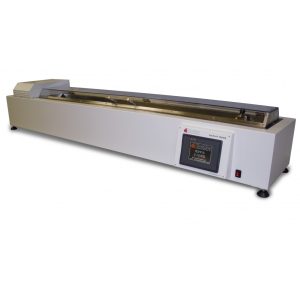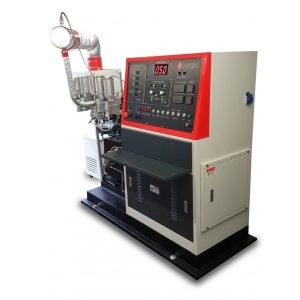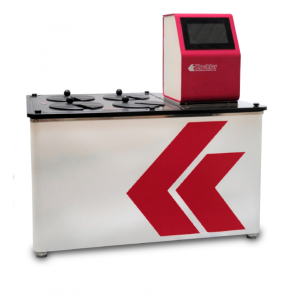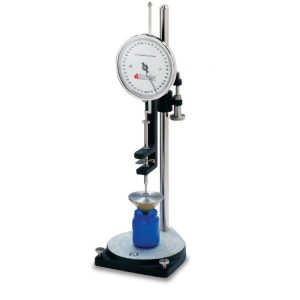Bitumen and Waxes
Showing all 12 results
-
Automated Flocculation Titrimeter
$13,000.00The Automated Flocculation Titrimeter (AFT) is a highly automated, computerized instrument that acquires oil stability and compatibility parameters directly. The AFT can be used to perform ASTM D6703 test method for Automated Heithaus Titrimetry. The instrument operates as a closed system with accurately controlled temperatures between 20-100°C, important for properly determining Heithaus compatibility parameters. The flocculation point is determined spectroscopically and the results are analyzed by the data acquisition system, virtually eliminating operator error in the interpretation of endpoints. A key benefit to the user is the fact that the asphaltene concentration can be calculated by the software much faster than traditional methods and with more accuracy. The utility of the original Heithaus method has been expanded by developing multiple titration schemes. The software uses the data from the expanded method to predict the proximity to coke formation during heavy oil distillation. Many refiners stop distillation short of coke formation to avoid fouling in distillation equipment, tanks and transfer lines. The expanded AFT methodology allows the refiner to recover additional distillate without the fear of fouling. This attribute of the instrument should allow up to a 1-2% increase in yields if applied to a process. Conversely, the added benefit of being able to predict coking tendency would prevent fouling of the process and thus decrease the use of energy in production as well as reduce down time due to having to clean vessels after fouling. One of the primary uses of Heithaus values is to predict the compatibility (P Index) of which oils and petroleum residua or asphalts can be mixed together for shipping, processing, or in formulations without causing phase separation. This is valuable to the refiner, researcher, or asphalt jobber who supplies petroleum asphalts for highway and roofing applications because it ensures that compatible asphalt blends are supplied. Incompatible asphalts show early failure in both applications. Coking Index (US Patent 6,773,921)-Stability also influences coke formation in the refining process. Another major use for the AFT is to acquire the data needed to employ the Coking Index. The Coking Index is a quantitative measure of the proximity to coking (fouling) during visbreaking, distillation, transfer and storage of heavy oil. This allows the petroleum refiner to optimize heavy oil processing and to recover the maximum amount of distillate, and to stop the processing before fouling occurs. Solubility Parameter-The solubility parameter at which asphaltenes begin to precipitate and the solubility parameter of the whole oil can be calculated from the AFT data.
-
Automatic Softening Point of Bitumen
$5,000.00Determines the softening point of bitumen in the range from 30 to 157°C (86 to 315°F) using the ring and ball apparatus immersed in distilled water (30 to 80°C), USP glycerin (above 80 to 157°C), or ethylene glycol (30 to 110°C).
-
Loss on Heat / Rolling Thin Film Oven
$17,000.00Double-walled electrically heated convection oven for rolling thin film oven tests on asphalts. Incorporates all required features per ASTM specifications, including: door with double-pane viewing window; symmetrical top and bottom vents; air plenum; squirrel cage-type 1725 rpm fan; digital indicating thermostat to control oven temperature at 163°C ±0.5°C; vertical circular carriage to mechanically rotate the samples at 15±0.2 rpm; air jets to blow heated air into each sample bottle at its lowest point of travel; and a calibrated flowmeter to control air flow at 4000 mL/min. An over-temperature cut-off circuit disconnects power to the unit in the event of control failure.
-
Loss on Heat / Thin Film Oven
$14,000.00Asphalt Oven
Dual purpose oven for loss of heat test and thin film test for bitumen and asphaltic materials. Interior chamber of stainless steel and stored powder painter steel exterior. Double glazed window in door for viewing test chamber. Side mounted controls comprise microprocessor digital control, independent overheat thermostat, main switch and indicator lamps. Two rotating platforms supplied to perform both tests.
-
Oil-Solvent Extractables Content Apparatus
$7,000.00Determines oil content or solvent extractables content in petroleum waxes in accordance with ASTM specifications. Includes Filter Stick Assembly; Cooling Bath; Air Pressure Regulator; and Evaporation Cabinet.
Filter Stick and Assembly – Filters petroleum wax samples per ASTM specifications. Consists of 10mm diameter sintered glass filter stick with air pressure inlet tube and delivery nozzle and a 25x170mm test tube. Inserts in Cooling Bath.
Cooling Bath – Accommodates three (3) 25x170mm test tubes for cooling samples and filter stick assemblies. Insulated stainless steel tank with finished steel exterior. Removable composition top plate has thermometer port, filling port and three 25.4mm (1″) test tube ports. Fill tank with suitable cooling mixture.
Air Pressure Regulator – Controls air flow to the filter stick assembly at the required rate. Mercury bubbler-type, with 250mL glass cylinder, T-tube and rubber stopper.
Evaporation Cabinet – Thermostatically heated cabinet evaporates solvent from filtrate per specifications. Accommodates four weighing bottles. Delivers air stream vertically downward into bottles through glass jets. Manifold assembly is adjustable for positioning of jets at the correct height above the sample surface. Controls temperature at 35 ±1°C (95 ±2°F). Finished steel cabinet with composition front plate and hinged glass door.
-
Omnitek BitU-Visc Automatic Viscometry System
$9,000.00The Omnitek BitU-Visc is a programmable, fully automatic kinematic viscometer specially designed to handle highly viscous samples at high temperatures. The system can process samples with viscosities ranging up to 120,000 mm2/s, up to 150 C.
There are 2 different models available: BitU-Visc 110 features a single thermostatic bath with 1 viscometer tube whereas the BitU-Visc 120 model holds 2 viscometer tubes in a single bath. All BitU-Visc instruments are equipped with auto-sampling, preheating, fully automatic dual solvent cleaning and drying.
The viscometer tubes are based on the well-known and proven Ubbelohde design. Using specially designed thermal sensors, these tubes allow the detection of fully opaque fluids without any problems or limitations and eliminate the need to use reverse flow tubes. The standard configuration offers viscosity measurement up to 150 C and sample preheating up to 200 C.
Sophisticated temperature control ensures that measurements are carried out well within the required temperature stability. The system features an innovative single position auto-sampling which provides integrated heating of the sample up to 200 C and uses preheated solvent to effectively clean the viscometer tube. The BitU-Visc is fitted with specially designed duplo viscometer tubes for unstable samples such as vacuum residues, additives, crude oils, waxes, heavy fuels oils, polymers, asphalts, etc., which typically show poor determinability when sampled repeatedly. These tubes have 2 measuring sections with an approximately similar tube constant. This allows for an actual duplo determination while only sampling once.
The BitU-Visc requires a PC (not included) for full operation and can be controlled through an advanced PC software application but it can also be controlled as a stand-alone unit through the responsive color touchscreen interface with a storage up to 10,000 measurement results. The PC software allows the operator to specify optimized and fully customizable test methods for each individual sample. For data collection, storage, calculations, and reporting, an advanced PC application is provided with the instrument, which can gather data from up to 4 instruments simultaneously.
The BitU-Visc utilizes advanced and easy to use multilingual software. One PC can control multiple systems (1 COM-port required for each instrument). Data can be exchanged with a LIMS via RS232 or via wireless. The instrument can be operated in its entirety through the PC interface. Sample ID’s can be loaded and sample queues can be started, halted or temporarily suspended. Results are automatically stored in the internal database and also can be stored on any external drive or network folder.
During a run, several kinds of information are shown like measured flow times (average and corrected), percent difference, viscosity result, bath temperature, set temperature, preheater temperature, sample ID, test method, measuring section and last results. Also, actual status like filling, cleaning, etc., is shown for every unit involved. Measured flow times are presented in left or right column, depending on whether the upper or lower measuring bulb is used for testing.
-
Pressure Aging Vessel
$13,000.00The Pressure Aging Vessel (PAV) is used to simulate in-service oxidative aging of asphalt binder according to procedures developed by the Strategic Highway Research Program (SHRP). The K88100 is fully compliant with the most recent ASTM and AASHTO standards for these tests. The complete PAV system consists of an ASME-code stainless steel pressure vessel in a stainless steel cabinet with encased band heaters, a precision sample holder for simultaneous testing of ten specimens, a set of ten TFOT specimen trays, a pressure controller, temperature controller, pressure and temperature measurement devices, temperature recorder, and a specimen loading and unloading tool. The K88100 PAV takes the hassle out of running and documenting asphalt binder aging operations. Three easy, non-complicated steps produce accurate and reliable results. Just press the “heat” button, insert specimens when prompted and press the “Age” button and let the PAV do the rest. Custom status screens guide the user step-by-step through the entire process. Each display screen (preheat start-up, preheat ready, aging heat up, aging pressurized, and aging complete) is simple and direct, with detailed process and status information. The final output screen, when the test is complete, shows the current vessel pressure, as well as minimum and maximum temperatures achieved during the test procedure. Process data (temperature and pressure) is continually stored at regular intervals in the programmable logic controller (PLC) that controls and monitors the process. The K88100 features a compact, bench-top design with integral pressure vessel. Its rotating vessel lid with rounded support block provides easy opening and closing. A built-in timer accumulates and records out-of-range time (out-of-range time for the PAV is typically less than 10 minutes during a 20-hour test). Minimum and maximum temperature data is recorded and is displayed at the end of each test.
-
Semi-Automatic Ductility Testing Machine
$2,000.00The Semi-Automatic Ductility Testing Machine is designed explicitly for testing the ductility and elastic recovery of bituminous materials. It features a 6” LCD touch screen control panel. This integrated touch screen allows the user to choose between the ductility or recovery test methods. The custom menu allows for the input of desired speed and time parameters. During testing, the distance traveled by the specimen is displayed and a simple touch of the screen can record the distance traveled upon breakage of the briquet. A motor jogging feature permits locking of the sample carriage without additional movement after the briquet sample is loaded into the machine.
-
Combination Octane Rating Unit Engine
$23,000.00The K90901 Standard Model Combination Octane Rating Unit is the latest model of octane engines with many easy-to-use features including automatic functions and enhanced documentation capabilities, conforming to the latest ASTM D2699 (RON) and ASTM D2700 (MON) test methods.
Through the engine’s operating panel, the parameters are adjustable according to the ASTM D2699 and D2700 specifications. The professional and clear design of the operating area makes the octane rating operation convenient and the data is easy to read and record. The auto-setting function of the octane engine effectively simplifies operational procedures and improves the efficiency of octane testing. The operating panel is equipped with a protect system and push-button switches to avoid improper operation.
-
Copper Strip Corrosion from Lubricating Grease
$11,000.00Immersion circulating water bath immerses Copper Strip Corrosion Test jars at the required depth per ASTM specifications. Use for testing lubricating oils and lubricating greases. Fully insulated, double-wall stainless steel construction.
-
Oxidation Stability Test Apparatus for Lubricating Greases
$22,000.00Oxidation Bomb
Stainless steel bomb consists of body, lid with stem and needle valve, and dish holder per ASTM specifications. Bomb interior surfaces and inside of stem have a high polish to facilitate cleaning. Safely withstands a working pressure of 180psi (1241kPa) at 99°C (210°F). Includes PTFE gasket seals (3) and cap screws with wrench. PTFE fluorocarbon seals are available (see Accessories).
Pressure Measurement & Recording Equipment
Select mechanical pressure gauges or, for greater convenience and accuracy in test reporting, the Oxidata® Pressure Management System designed expressly for ASTM oxidation tests. Pressure gauge measures pressure inside Oxidation Bomb with accuracy of better than 0.5psi (3.45kPa) in accordance with ASTM specifications. Range: 0-160psi (0-1100kPa), graduated in 1psi intervals. Cleaned for oxygen service.
Oxidation Bath
Constant temperature oil bath holds bombs at the proper depth for determining oxidation stability of lubricating greases Fully digital touch screen controller provides quick temperature stabilization without overshoot, and the bath is protected by a redundant overtemperature control circuit that interrupts power should bath temperature exceed a programmed cut-off point. Display provides actual setpoint temperature values in °C/°F format. Contact your Koehler representative for information. Heavily insulated welded stainless steel bath interior has a bomb support rack and overflow standpipe/drain to maintain proper working depth. Steel exterior has a corrosion resistant polyurethane enamel finish
-
Penetrometer
$3,000.00Designed for ASTM penetration tests on petroleum products and for consistency tests on a wide range of food products, cosmetics, pastes and other solid to semi-solid products. Precision machined and assembled to exacting specifications, and ruggedly constructed to ensure long service life in both laboratory and field applications. Features a full penetration range of 0-62.0mm with 1⁄10mm subdivisions (0-620 penetration scale). Accommodates cones and needles to perform all of the ASTM tests on lubricating greases, asphalts, petroleum waxes and petrolatums. Compact design facilitates transport for field use. Head assembly adjusts for accurate placement of the tip of the needle or cone on the surface of the sample. Sturdy cast iron base provides excellent support and has a built-in spirit level and leveling screws to ensure proper alignment of the penetrometer during testing. Supplied with 50 and 100 gram weights and standard 47.5g plunger assembly. Order test cones, needles and lightweight plunger (where applicable) separately.


